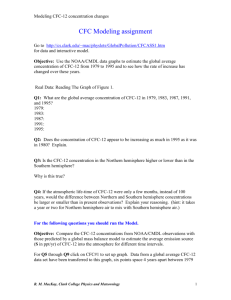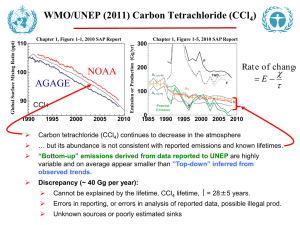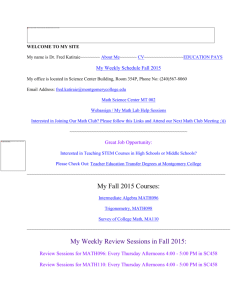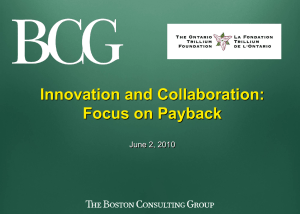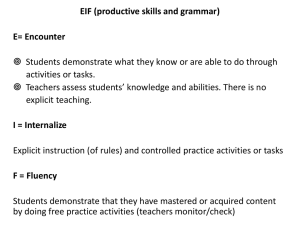CFCModelAss
advertisement
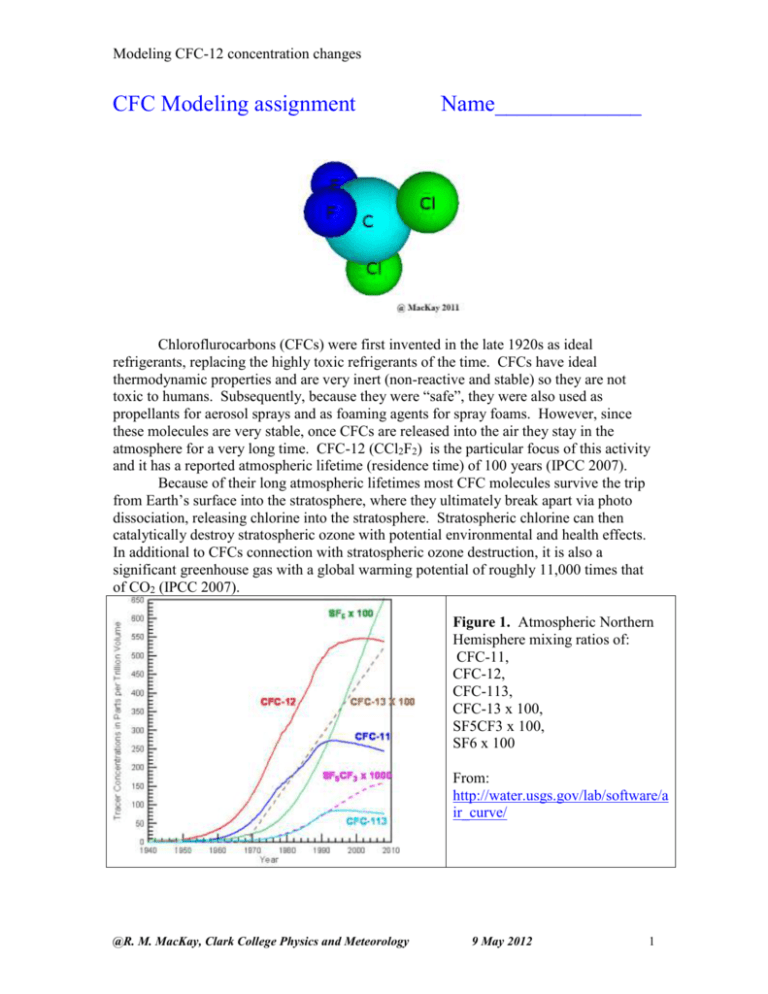
Modeling CFC-12 concentration changes CFC Modeling assignment Name_____________ Chloroflurocarbons (CFCs) were first invented in the late 1920s as ideal refrigerants, replacing the highly toxic refrigerants of the time. CFCs have ideal thermodynamic properties and are very inert (non-reactive and stable) so they are not toxic to humans. Subsequently, because they were “safe”, they were also used as propellants for aerosol sprays and as foaming agents for spray foams. However, since these molecules are very stable, once CFCs are released into the air they stay in the atmosphere for a very long time. CFC-12 (CCl2F2) is the particular focus of this activity and it has a reported atmospheric lifetime (residence time) of 100 years (IPCC 2007). Because of their long atmospheric lifetimes most CFC molecules survive the trip from Earth’s surface into the stratosphere, where they ultimately break apart via photo dissociation, releasing chlorine into the stratosphere. Stratospheric chlorine can then catalytically destroy stratospheric ozone with potential environmental and health effects. In additional to CFCs connection with stratospheric ozone destruction, it is also a significant greenhouse gas with a global warming potential of roughly 11,000 times that of CO2 (IPCC 2007). Figure 1. Atmospheric Northern Hemisphere mixing ratios of: CFC-11, CFC-12, CFC-113, CFC-13 x 100, SF5CF3 x 100, SF6 x 100 From: http://water.usgs.gov/lab/software/a ir_curve/ @R. M. MacKay, Clark College Physics and Meteorology 9 May 2012 1 Modeling CFC-12 concentration changes Because of their negative environmental effects, in 1992 the international community called for a complete phase out of CFC production. In this activity we use a simple mass balance model for atmospheric CFC-12 to help us better understand past and future atmospheric concentrations of this important trace gas. We choose CFC-12 since its past emissions and long atmospheric lifetime (100 years) will keep CFC-12 concentrations relatively high throughout this century, see Figure 1 above. The mass balance model is similar in structure to the water tank model use in a previous activity. S will represent the emissions of CFC-12 into the atmosphere (parts per trillion per year), C the atmospheric concentration of CFC-12 , and the removal rate (RR) is taken as RR=C/lifetime. Part 1: Real Data: Reading the Graph of Figure 1 (click here to get a larger image, including references, of that show below) Ctrl-click image to enlarge Part 1 Objective: Use the NOAA/CMDL data graphs Graph of Figure 1 to estimate the global average concentration of CFC-12 from 1979 to 1995 and to see how the rate of increase has changed over these years. Q1: Estimate the global average concentrations of CFC-12 in 1979, 1983, 1987, 1991, and 1995? To read the graph above Ctrl-click on it to enlarge it. The CFC concentration between Mauna Loa and American Somoa observatories is a good estimate of the global average concentration. 1979: ____________ 1983: ____________ 1987: ____________ 1991: ____________ 1995: ____________ @R. M. MacKay, Clark College Physics and Meteorology 9 May 2012 2 Modeling CFC-12 concentration changes Q2: Does the concentration of CFC-12 appear to be increasing as much in 1995 as it was in 1980? Explain. Q3: Is the CFC-12 concentration in the Northern hemisphere higher or lower than in the Southern hemisphere? Why is this true? Q4: If the atmospheric life-time of CFC-12 were only a few months, instead of 100 years, would the difference between Northern and Southern hemisphere concentrations be larger or smaller than in present observations? Explain your reasoning. (hint: it takes a year or two for Northern hemisphere air to mix with Southern hemisphere air.) Q5: The figure below shows Dupont’s estimate of total atmospheric chlorine and the chemical source of this chlorine. The source of chlorine at the bottom of the list is methyl chloride (CH3Cl) and is produced naturally in the oceans. The other source of chlorine are anthropogenic in origin. In the early 1980s there was some media controversy regarding atmospheric Chlorine and stratospheric ozone depletion. Some argued “why worry about chlorine in the atmosphere since it occurs naturally anyway”. Use estimates from the figure below to calculate the percentage of total chlorine in the atmosphere linked to natural chlorine in 1985. Repeat this calculation for 1995. Use the table below to help organize your results. year Total chlorine (ppt) Natural Chlorine (ppt) % of total that is natural 1985 1995 Does the statement “why worry about chlorine in the atmosphere since it occurs naturally anyway”. have merits? ANS _____________________ @R. M. MacKay, Clark College Physics and Meteorology 9 May 2012 3 Modeling CFC-12 concentration changes Part 2: Global Emissions Estimates for CFC-12 Go to http://www.atmosedu.com/physlets/GlobalPollution/CFCASS1.htm for data and interactive model. Watch the youtube video introducing the user interface for the modeling environment. For the following questions you should run the model. Objective: To estimate the average emissions (S in ppt/yr) of CFC-12 into the atmosphere between 1980 and 1999. We will do this by comparing the global mean CFC-12 concentrations from NOAA/CMDL observations with those predicted by a global mass balance model. For Q5 through Q9 click on CFC#1 to set up the graph. Data from a global average CFC-12 data set have been transferred to this graph. Each data point is the annual mean value of that global average. This allows us to use the model to better understand the observations. Use 100 years for atmospheric lifetime of CFC-12 for all simulations in this assignment since that is its published valued. @R. M. MacKay, Clark College Physics and Meteorology 9 May 2012 4 Modeling CFC-12 concentration changes Q5: Change the emissions (So) and possibly C0 to get the best fit between the model and the first five years of observations [1980 through 1985]. What value of So gives the best fit to these two points? Use your subjective judgment to obtain the best fit as oppose to some statistical test. The image at right shows a good fit between model and observations 5 or 6 years. Best fit So:__________ Q6: Change the emissions So and the initial concentration C0 to get the best fit between the model and the 1985 through 1989 observations. What value of So gives the best fit for 1985 through 1989 data? So: __________ Q7: Based on the above results, would you say that the emissions of CFC-12 from factories were increasing, decreasing, or staying the same during the 1980s? Q8: Is it a good assumption to say that emission of CFC-12 were constant during the 1980s? Explain. @R. M. MacKay, Clark College Physics and Meteorology 9 May 2012 5 Modeling CFC-12 concentration changes Q9: Change the emissions So and the initial concentration C0 to get the best fit between the model and the 1989 through 1983 observations. What value of So gives the best fit for 1989 through 1993 data? So: __________ Based on your result for Q9 and a visual inspection of the steepness of the graph through the 1990s would you say the emissions of CFC-12 increased, decreased, or stayed the same during the 1990s? Future Projections of CFC-12 (business as usual) Objectives: Explore the future projections of CFC-12 if the emission source strength remained at its 1980s value into the future. For Q10 through Q13 click on CFC#2 to set up graph. Assume that C0=294 ppt (its 1980 value), So =22ppt/year an average value based on the data, and R=0.0 (constant value of S). Q10: For these values what is the concentration 100 years after the run starts (in 2080)? _____________ Q11: What would be the final equilibrium concentration of CFC-12 if the emission source were kept fixed at 22 ppt/year? (hint: you should be able to calculate this without using the model if you remember that the equilibrium concentration Ceq=S where is the atmospheric lifetime, for CFC-12 100 yrs) _____________ Q12: If through international agreements the CFC-12 emissions were cut in half to 11 ppt/yr (instead of 22 ppt/yr) what would be the CFC-12 concentration in the year 2080? _____________ @R. M. MacKay, Clark College Physics and Meteorology 9 May 2012 6 Modeling CFC-12 concentration changes How much larger is this than the starting concentration in 1980 value of 294 ppt? (use a ratio so you can say how many times larger) _____________ Q13: Based on the knowledge that significant stratospheric ozone loss was linked to CFC concentrations in the early 1990s when the CFC-12 concentration was about 460 ppt, discuss the merits of the international policy described in Q12. Specifically address: 1. Whether the emission reduction is large enough to halt the stratospheric ozone loss and 2. whether you would expect the stratospheric ozone hole to grow larger or to get smaller under this "50% -emission-reduction" policy. Future Projections of CFC-12 (with mitigation) Objective: Explore future CFC-12 concentrations with assumed scenarios of emission reduction rates. For Q14 through Q19 click on CFC#3 to set up graph. This graph assumes that an initial CFC-12 concentration C0=475 ppt (its 1990 value) and the 1990 emissions are So=18 (ppt/year), an average value based on our previous data analysis. The Montreal Protocol (revised in Copenhagen in 1992) called for the complete phase out of F-12. The questions below relates to accomplishing this task. Q14: Let R=0.0 (no growth or reduction in emissions) so S is fixed at its 1990 value of 18 ppt/yr). How long after 1990 does it take the concentration of CFC-12 to double? (Click the clear button in the interface before running and then read the numerical output from the model in the table at right) ______________ Q15: Let R= - 5.0 (emission reduction of 5% per year after 1990). How long does it take before the concentration of CFC-12 gets back to its 1990 value of 475 ppt. What is the maximum value of CFC-12 reached after 1990? (Again, click clear before running and then read the numerical output from the model in the table at right) time to get back to 475 ppt:________________ Max CFC-12 concentration:_______________ Q16: repeat Q15 for R=-15.0 @R. M. MacKay, Clark College Physics and Meteorology 9 May 2012 7 Modeling CFC-12 concentration changes time to get back to 475 ppt: _______________ Max CFC-12 concentration: _______________ Q17: repeat Q15 for R=-100.0. This corresponds to the complete phase out of CFC-12 after 1 year. time to get back to 475 ppt: _______________ Max CFC-12 concentration: _______________ Q18: The actual CFC-12 concentrations are show in black dots. Play around with R until you get the “best fit to the 1990-2012 data. Which value of R best fits the observed 1990 and 2004 CFC-12 concentration values? R (best fit)= Q19: Run the 4 simulations corresponding to the 4 different R values all on the same graph. Using the Run1 (R=-5), Run2 (R=-15), Run3 (R=-100), and Run4 (your best fit) buttons makes this easy. Copy and paste this graph in the space below (replacing the graph below). Using the Alt-PrntScrn keys allows you to copy the screen to the computer’s clipboard and then it can be easily pasted into the “paint program” and modified and then inserted into this word document. Clearly label each curve with its corresponding R value. Objectives: The questions below are intended help synthesize the ideas presented earlier and to show how these concepts are related to real world applications. @R. M. MacKay, Clark College Physics and Meteorology 9 May 2012 8 Modeling CFC-12 concentration changes Q20: The following ordered pairs of (So in ppt/yr, R in%) with C0=475 ppt are used to run the model starting from 1990 to estimate future CFC-12 concentrations. A=(20, -5) , B=(20,+5), C=(0,80), D=(0,0), & E=(20,-10). Rank each from highest to lowest year 2030 concentration. Run the model to check your answers. Highest lowest Q21: A friend tells you that a particular global pollutant is under control now since industry has stopped increasing production (emissions rate increase is zero, R =0.0) for this pollutant. What three key pieces of information would you need to know before you could respond to your friend's assertion and estimate future concentrations of this pollutant? 1. _______________ 2. _______________ 3. _______________ Q22: A speaker from a local factory states that the emissions from their factory are very clean since most of it is water vapor and steam. Give examples of at least two other questions worth asking this person regarding the emissions from their factory? Q23: Evaluate the merits of the following hypothetical argument. Use at least two results from a model run in your evaluation. Also consider model projections of CFC concentrations over the next 100 years. In the middle 1980s observations indicated that atmospheric concentrations of CFC-12 were increasing and that the CFCs were causing stratospheric ozone depletion and possibly global warming. Because of this, world governments agreed to hold emissions (S) of CFC-12 fixed at their 1980 levels (of about 20 ppt/yr) with the idea that this will help control future CFC concentrations and curtail negative environmental impacts (global warming from CFCs and stratospheric ozone depletion). Use our model to evaluate the merits of this policy. Assuming the the 1980 CFC concentration is 294 ppt what will be the 2020 concentration if the CFC emissions are fixed at 20 ppt (20 ppt is a good estimate of the 1980 emissions)? Will this policy work? Why or why not. How much would emissions have to change from their estimated 1980s level of 22 ppt.yr to keep CFC-12 from going over 500 ppt? Include at least one screen capture of a model simulation to help support your statements. @R. M. MacKay, Clark College Physics and Meteorology 9 May 2012 9 Modeling CFC-12 concentration changes References. 1. Climate Change 2007: Working Group I: The Physical Science Basis, Contribution of Working Group I to the Fourth Assessment Report of the Intergovernmental Panel on Climate Change, 2007 Solomon, S., D. Qin, M. Manning, Z. Chen, M. Marquis, K.B. Averyt, M. Tignor and H.L. Miller (eds.) Cambridge University Press, Cambridge, United Kingdom and New York, NY, USA. 2. CFC-12 data from http://www.esrl.noaa.gov/gmd/hats/combined/CFC12.html @R. M. MacKay, Clark College Physics and Meteorology 9 May 2012 10
